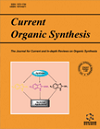- Home
- A-Z Publications
- Current Organic Synthesis
- Previous Issues
- Volume 17, Issue 7, 2020
Current Organic Synthesis - Volume 17, Issue 7, 2020
Volume 17, Issue 7, 2020
-
-
Recent Achievement in the Synthesis of Benzo[b]furans
More LessBy Dau X. DucBackground: Benzo[b]furan derivatives are oxygen-containing heterocyclic compounds consisting of fused benzene and furan rings and are present in a large number of natural and non-natural compounds. This class of compounds has a wide spectrum of biological activities, such as antiarrhythmic, anticancer, inflammatory, antioxidant, antimicrobial, and antiviral. Furthermore, benzo[b]furan derivatives have also be Read More
-
-
-
Nucleophilic Acylation with Aromatic Aldehydes to 2 Bromoacetonitrile: An Umpolung Strategy for the Synthesis of Active Methylene Compounds
More LessAuthors: Shailesh Singh, Jyoti Tiwari, Deepali Jaiswal, Amit K. Sharma, Jaya Singh, Vandana Singh and Jagdamba SinghBackground: A novel one-pot N-heterocyclic carbene (NHC)-catalysed acylation of 2- bromoacetonitrile with aromatic aldehydes is reported. The protocol involves carbonyl umpolung reactivity of aldehydes in which the carbonyl carbon attacks nucleophilically (as d1 nucleophile) on the electrophilic terminal of 2-bromoacetonitrile to afford 3-aryl-3-oxopropanenitrile. The salient features of this procedure are short reactio Read More
-
-
-
New Potential Biologically Active Compounds: Synthesis and Characterization of Urea and Thiourea Derivativpes Bearing 1,2,4-oxadiazole Ring
More LessAuthors: Nevin Arıkan Ölmez and Faryal WaseerBackground: Urea, thiourea, and 1,2,4-oxadiazole compounds are of great interest due to their different activities such as anti-inflammatory, antiviral, analgesic, fungicidal, herbicidal, diuretic, antihelminthic and antitumor along with antimicrobial activities. Objective: In this work, we provide a new series of potential biologically active compounds containing both 1,2,4-oxadiazole and urea/thiouprea moiety. Materials a Read More
-
-
-
Thietanyl Protection in the Synthesis of 8-Substituted 1-Benzyl-3-methyl-3,7-dihydro- 1H-purine-2,6-diones
More LessAuthors: Ferkat Khaliullin and Yuliya ShabalinaAim and Objective: 1-Alkyl-3,7-dihydro-1H-purine-2,6-diones containing no substituents in the N7 position can be synthesized only using protecting groups, for example, benzyl protection. However, in the case of synthesis of 1-benzyl-3,7-dihydro-1H-purine-2,6-diones, the use of benzyl protection may lead to simultaneous debenzylation of both N1 and N7 positions. Therefore, it is necessary to use other protective groups for the sy Read More
-
-
-
Electrochemical Oxidative Esterification of Thiophenols: Efficient Access to Sulfinic Esters
More LessAuthors: Chun-Hui Yang, Cheng Wu, Jun-Ming Zhang, Xiang-Zhang Tao, Jun Xu, Jian-Jun Dai and Hua-Jian XuBackground: The sulfinic esters are important and useful building blocks in organic synthesis. Objective: The aim of this study was to develop a simple and efficient method for the synthesis of sulfinic esters. Materials and Methods: Constant current electrolysis from thiols and alcohols was selected as the method for the synthesis of sulfinic esters. Results and Discussion: A novel electrochemical method for the synthesis of s Read More
-
-
-
Synthesis and Antimicrobial Evaluation of Some Novel Pyrimidine, Pyrazole, Chromene and Tetrahydrobenzo[b]thiophene Derivatives Bearing Pyrimidinthione Moiety
More LessAim and Objective: A novel collection of fused pyrimidine, pyridine, pyrazole, chromene and thiophene derivatives 2-30 have been newly synthesized by using the 1a, b as starting material. Fused pyrane exhibits a range of pharmacological activity such as cancer agents [1], antimicrobial [2-4], antioxidant [5], antiproliferative [6], cytotoxic activity [7], anticipated antitumor [8], antiparkinsonian [9] and anti-infl Read More
-
-
-
Biosynthesis, Characterization and Mechanism of Formation of ZnO Nanoparticles Using Petroselinum Crispum Leaf Extract
More LessAim: The study aimed at synthesizing ZnO NPs using Petroselinum crispum extract, commonly known as parsley, as a source of biosynthesis without utilizing chemical agents for reducing, capping and stabilizing agent. Background: Recently, the biosynthesis of nanoparticles has been widely explored due to the wide range of vital applications in nanotechnology. Biosynthesized zinc oxide nanoparticles, ZnO NPs, have become i Read More
-
-
-
Synthesis of New Cyanopyridine Scaffolds and their Biological Activities
More LessBackground: 3-Cyanopyridine analogues are significant moieties with a variety of biological effects such as antioxidant, antimicrobial, anti-inflammatory and cytotoxic agents. In addition, they could be applied in the treatment of several diseases. Objective: The study conducted cyclo-addition of 3a-e derivatives with malononitrile to yield the corresponding 6-(4-((3-cyano-pyridinyl) amino) phenyl)-4-phenylnicotinonitrile Read More
-
-
-
Indol-2-Carboxylic Acid Esters Containing N-Phenylpiperazine Moiety - Preparation and Cholinesterase-inhibiting Activity
More LessBackground: The indole derivatives and the N-phenylpiperazine fragment represent interesting molecular moieties suitable for the research of new potentially biologically active compounds. This study was undertaken to identify if indol-2-carboxylic acid esters containing N-phenylpiperazine moiety possess acetylcholinesterase and butyrylcholinesterase inhibitory activity. Materials and Methods: The study dealt with the synthe Read More
-
-
-
Short Protecting Group-free Syntheses of CDE Synthon of Racemic Camptothecin
More LessAuthors: Pingxuan Shao, Wei Lu and Lei WangA practical and concise total synthesis of tricyclic ketone 7 (CDE ring), a valuable intermediate for the synthesis of racemic camptothecin and analogs, was described (8 chemical steps and 29% overall yield). The synthesis starts with two inexpensive, readily available materials and is operationally simple to perform. It is worth mentioning that the reported protecting group-free synthesis, with advantages of a short rou Read More
-
Volumes & issues
-
Volume 22 (2025)
-
Volume 21 (2024)
-
Volume 20 (2023)
-
Volume 19 (2022)
-
Volume 18 (2021)
-
Volume 17 (2020)
-
Volume 16 (2019)
-
Volume 15 (2018)
-
Volume 14 (2017)
-
Volume 13 (2016)
-
Volume 12 (2015)
-
Volume 11 (2014)
-
Volume 10 (2013)
-
Volume 9 (2012)
-
Volume 8 (2011)
-
Volume 7 (2010)
-
Volume 6 (2009)
-
Volume 5 (2008)
-
Volume 4 (2007)
-
Volume 3 (2006)
-
Volume 2 (2005)
-
Volume 1 (2004)
Most Read This Month
Article
content/journals/cos
Journal
10
5
false
en


